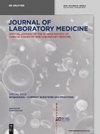Status of liquid profiling in precision oncology – the need for integrative diagnostics for successful implementation into standard care
IF 1.8
4区 医学
Q4 MEDICAL LABORATORY TECHNOLOGY
引用次数: 1
Abstract
Abstract The liquid profiling approach is currently at the threshold of translation from research application in various clinical trials to introduction into the management of cancer patients in the context of clinical care. Routine application has focused primarily on the analysis of single blood-based biomarkers for companion diagnostics. However, liquid profiling promises much broader diagnostic potential, which is discussed and illustrated in this manuscript through several case reports. These clinical cases range from identification of druggable targets to the detection of subclonal resistance mechanisms. In addition, liquid profiling can be used in clinical practice to identify complex molecular patterns or as a personalized tumor marker for patient-specific monitoring of response to treatment. These examples highlight both the value and limitations of liquid profiling in various clinical settings, which could be overcome by an integrative diagnostic approach with imaging techniques. The complementary advantages of both diagnostics approaches will allow combining high sensitivity with genetic tumor profiling and topologic assignment. Therefore, we advocate interdisciplinary integrated collaboration between laboratory and imaging experts to unravel the potentials of precision diagnostics in cancer care.精确肿瘤学中液体分析的现状——需要综合诊断才能成功实施到标准护理中
摘要液体分析方法目前正处于从各种临床试验中的研究应用转化为临床护理中癌症患者管理的临界点。常规应用主要集中在分析基于单个血液的生物标志物,用于伴随诊断。然而,液体分析具有更广泛的诊断潜力,本文通过几个案例报告对其进行了讨论和说明。这些临床病例的范围从药物靶点的鉴定到亚克隆耐药性机制的检测。此外,液体图谱可以在临床实践中用于识别复杂的分子模式,或作为个性化的肿瘤标志物用于患者对治疗反应的特异性监测。这些例子突出了液体分析在各种临床环境中的价值和局限性,这可以通过结合成像技术的综合诊断方法来克服。两种诊断方法的互补优势将允许将高灵敏度与遗传肿瘤图谱和拓扑分配相结合。因此,我们提倡实验室和成像专家之间的跨学科综合合作,以揭示癌症护理中精确诊断的潜力。
本文章由计算机程序翻译,如有差异,请以英文原文为准。
求助全文
约1分钟内获得全文
求助全文
来源期刊

Journal of Laboratory Medicine
Mathematics-Discrete Mathematics and Combinatorics
CiteScore
2.50
自引率
0.00%
发文量
39
审稿时长
10 weeks
期刊介绍:
The Journal of Laboratory Medicine (JLM) is a bi-monthly published journal that reports on the latest developments in laboratory medicine. Particular focus is placed on the diagnostic aspects of the clinical laboratory, although technical, regulatory, and educational topics are equally covered. The Journal specializes in the publication of high-standard, competent and timely review articles on clinical, methodological and pathogenic aspects of modern laboratory diagnostics. These reviews are critically reviewed by expert reviewers and JLM’s Associate Editors who are specialists in the various subdisciplines of laboratory medicine. In addition, JLM publishes original research articles, case reports, point/counterpoint articles and letters to the editor, all of which are peer reviewed by at least two experts in the field.
 求助内容:
求助内容: 应助结果提醒方式:
应助结果提醒方式:


